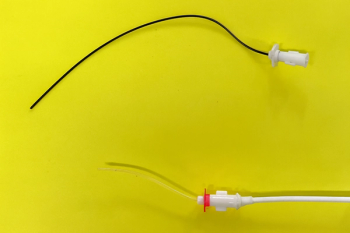
The value of a urinalysis (Proceedings)
One of the simplest and most cost effective diagnostic tools is at our disposal every day in practice, however we often overlook it and the large amount of data that it provides us. Urinalysis, including fresh sediment examination, can provide additional important information that complements and enhances the diagnostic information we gain from other diagnostic modalities such as serum chemistry, CBC, and the all-important physical examination.
One of the simplest and most cost effective diagnostic tools is at our disposal every day in practice, however we often overlook it and the large amount of data that it provides us. Urinalysis, including fresh sediment examination, can provide additional important information that complements and enhances the diagnostic information we gain from other diagnostic modalities such as serum chemistry, CBC, and the all-important physical examination. The purpose of this discussion is to review the type of information we gain from a urinalysis, how to interpret it and integrate it with other information.
Quick Review of Procedure
Note how sample was obtained (free catch, catheter, cystocentesis) and whether the sample was refrigerated or stored prior to evaluation. Note color and appearance (clear, turbid). Bring sample to room temperature if it has been refrigerated.
Save a small portion in a sterile container for possible culture. This prevents an additional collection procedure if you choose to culture after reviewing the sediment.
Perform specific gravity estimation using a properly calibrated (distilled water = 1.000) refractometer. The pad on the dipstrip to estimate USG is not accurate in dogs and cats. If the refractometer you are using does not go higher than 1.035, mix equal parts of urine and distilled water and measure the USG. Multiply the numbers to the right of the decimal by 2. Example: 1.024 diluted = 1.048 undiluted.
Centrifuge the urine (preferably 5-10 ml) at 1000 – 1500 rpm for 5 min. Perform dipstrip evaluation on the supernatant. You do not have to spin the urine first, but it is ideal.
Dipstrip Evaluation: Be sure strips are not expired and are stored away from light and extreme temperatures. Place a small drop of urine on each pad, enough to saturate it and hold strip horizontally or place on a counter to prevent reagents from running from one pad to the other. The pads are time sensitive. Read each pad at the time interval specified by the manufacturer with good lighting. Do not use the leukocyte pad in dogs and cats since it is inaccurate.
Sediment: Normal fresh urine should have very few elements in it. You do not have to use a supra-vital stain (Sedi-Stain), but if you do, be sure it is well mixed and not expired or evaporated. This can lead to sediment artifacts that can be read out as bacteria. Follow directions for its use. Place a drop of centrifuged urine on a slide and place a coverslip over it. Examine under low light under both 10X (casts) and 40X (cells) with the condenser down.
• 40X: # RBCs/hpf, #WBCs/hpf, # and type epithelial cells/hpf, bacteria (rod vs. cocci, intracellular), # and type of crystals/hpf (struvite, CaOx, cysteine, urate, amorphous ammonium biurate)
• 10X: # and type of Casts/lpf (cellular, granular, waxy, hyaline)
Collection method
Free catch:
• Pros – Easy, free, client can do at home, little to no effect on specific gravity, ketones or glucose levels, little to no risk, may be a good way to screen for hematuria since other methods may have artifactual hematuria introduced.
• Cons – Due to normal bacterial flora and secretions in the distal urogenital tract the culture results, protein, and WBCs can be affected, can be challenging in cats. Can use clear plastic wrap over litterbox or non-absorbable litter (NoSorb®).
Catheterization:
• Pros – easy in male dogs, may require sedation in females and male cats (rarely used for routine collection in male cats).
• Cons – can introduce bacterial contamination into the lower urinary tract as well as into the sample, can introduce protein, epithelial cells and RBCs into sample through trauma associated with the technique, can cause trauma or rupture of the urethra, esp. in male cats.
Cystocentesis:
• Pros – Can be relatively easy in animals with a palpable bladder, best choice for culture of urine, avoid contamination of sample with bacteria, WBCs, protein, and epithelial cells (RBCs may be introduced if a "traumatic stick"), well tolerated, fast, complications are rare.
• Cons – requires comfort and understanding of the procedure, risk of complications if patient is thrombocytopenic (< 30,000), has a coagulopathy, or a devitalized bladder wall, may cause seeding for TCC tumor cells along needle tract if present in the bladder, rare complication of vagovagal response in a cat (collapse, vomiting).
Specific gravity
This is often the most important piece of information regarding renal function. Even if a full urinalysis is not performed, it is important to obtain a urine specific gravity reading in conjunction with serum chemistry and prior to any fluid therapy in an ill patient in order to assess the urine concentrating ability and renal function. Loss of adequate concentration ability occurs at ~ 60% GFR loss, whereas azotemia does not develop until ~ 75% of GFR is lost. Thus the USG is an earlier and more sensitive marker of renal function. Often, differentiation between pre-renal and renal azotemia requires a urine specific gravity. The USG can be performed on free catch urine without much problem and requires only a small amount. In patients in which you are evaluating for concentration ability, it is best to use a "first morning sample" before the animal eats or drinks since this and exercise will affect the USG. It is important to interpret other findings (protein, cell #s) of the UA in light of the USG. For example, a 1+ protein may be clinically unimportant in urine with a USG of 1.065, but is very significant in urine with a USG of 1.010. Animals on all canned food diets may have lower USG than animals on all dry food diets. Significant (> 1000mg/dl) glucosuria and proteinuria can cause mild increases in USG.
Dipstrip
Ph:
Normal pH is 5.0 – 7.5 in carnivores (dogs and cats). Diet can have a profound effect on the pH of the urine. The urine is not considered an accurate way to assess systemic acid-base status since several diseases can cause paradoxical aciduria or alkyluria (i.e. distal tubular acidosis). It is well known that urease-producing bacteria (Staph. and Proteus) will lead to an increase in the pH of the urine; however, acidic urine does not rule out a UTI since there are many non-urea splitting bacteria which are uropathogens. Overly acidic urine can be irritating to the bladder mucosa and may exacerbate flares in cats with Feline Interstitial Cystitis (FIC).
Protein:
The dipstrip pad primarily detects albumin more than globulin. Level of protein in the urine must be interpreted in light of the urine concentration. It is not unusual to see trace or 1+ protein in urine that is highly concentrated. Pink or red urine due to hemorrhage and urine with significant pyuria can lead to mild increases in protein. Any protein in isosthenuric urine and significant protein in more concentrated urine should be further investigated since this can be an important indicator of glomerular disease, tubulointerstitial disease, pyelonephritis, neoplasia, or other inflammatory disease. A urine protein creatinine ratio may be performed to quantify the amount of proteinuria. Microalbuminuria tests are also available that will detect very small amounts of protein.
Glucose:
Normally, any glucose that is filtered through the glomerulus is reabsorbed in the proximal tubule. Therefore, and glucose in the urine indicates either overwhelming of these processes (hyperglycemia) or dysfunction of the proximal tubule with a normal blood glucose (i.e. Fanconi's syndrome). Differentiation between these two is achieved by evaluating the blood glucose at the time of urine sampling. The two must be performed together since cats can have stress-induced hyperglycemia which may cause transient spill-over into the urine. Renal threshold for glucose in the cat is ~300 mg/dl and ~180 mg/dl in the dog).
Ketones:
Not normally present in dogs and cats. Positive reactions associated with inadequate utilization of carbohydrates for energy. Thus dogs and cats experiencing starvation as well as diabetic ketosis/ketoacidosis will be kenonuric. Pad only detects 2 (acetoacetate, acetone) of the 3 kinds of ketones (β-hydroxybuterate).
Occult blood:
This pad detects RBCs, free hemoglobin, and myoglobin in the urine. In order to differentiate RBCs from pigment, the urine should be centrifuged and the RBCs should be spun out of the supernatant. It is difficult to determine the difference between myoglobin and hemoglobin without urine electrophoresis (however, a significantly elevated creatine kinase or AST may indicate muscle breakdown/damage). It is not unusual to see "trace" blood from cystocentesis sampling, but this is not always the case and should be confirmed with a free-catch sample. The presence of blood in a urine sample taken by cystocentesis indicates bleeding from the "bladder or above" but may also be washed back into the bladder from the proximal urethra or the prostate. If the sample is taken by catheterization or free catch, it is more difficult to determine the origin of the hemorrhage. Comparison of urine from a cystocentesis and free catch may assist in determining the origin of the blood.
Bilirubin:
This is the breakdown product of heme and is increased in patients with RBC lysis or hepatobiliary dysfunction. Trace or 1+ amounts may be seen in dogs with concentrated urine (esp. males) but it is never normal in feline urine. Bilirubin may show up in the urine of animals (esp. dogs) prior to clinically detectable icterus. Any bilirubinuria should prompt a CBC or at least a packed cell volume estimation and blood smear evaluation for hemolysis. If none is found, investigation of the hepatobiliary system is warranted.
Sediment examination
RBCs:
Up to 5-8 RBCs/hpf may be found if a cystocentesis or catheterized sampling was traumatic or may be normal in free catch samples. Evaluating samples obtained by different methods may assist in localizing their source. It is important not to ignore the genital tract (uterus, vagina, prostate) as a source of hemorrhage in free catch samples, even from neutered/spayed animals. While UTI is often a cause of hematuria, in cats < 10 years of age this is rarely the case and the source is more likely FIC or urolithiasis. In patients with hematuria, urine culture and imaging of the urogenital tract is often indicated to evaluate for mass lesions or uroliths.
WBCs:
As with RBCs, 5-8 WBCs/hpf may be normal in free catch or catheterized samples. Usually 0-3/hpf in cystocentesis samples. Increased WBCs (pyuria) often indicate a UTI, however, sterile inflammation (esp. cats with FIC) can also cause WBCs to appear in increased numbers in the urine. Clumping of WBCs may be more likely with a UTI. Patients with elevated WBCs in the urine should have a urine culture performed. Special care should also be taken in these patients to examine the urine sediment for bacteria.
Epithelial cells:
Transitional, squamous, and renal epithelial cells may be seen on urinalysis.
• Transitional cells come from anywhere from the renal pelvis to the trigone and may be increased due to inflammation or trauma in the urinary tract. Clumps of transitional cells, especially if they have neoplastic changes (multiple nucleoli, coarse chromatin, mitotic figures, basophilia) may indicate transitional cell carcinoma and warrant further investigation of the urinary tract with imaging.
• Squamous are usually large and of no diagnostic importance and may be contaminants from the skin or catheterization.
• Renal epithelial cells are from the tubules or renal pelvis and are never normal. They may be indicative of acute renal damage such as toxic or ischemic nephropathy or in degenerative renal disease.
Casts:
These elements are cylindrical precipitates of protein and/or cells that form in the renal tubules and are thus "molds" of the tubules. Since they form only in the kidneys, they indicate pathology of renal origin. 0-2 hyaline casts and 0-1 granular casts may be normal. These are often very fragile and may only be seen when the sediment is examined within 15 min. of collection.
• Hyaline: pure precipitated Tamm-Horsfall protein, can dissolve quickly in dilute and alkaline urine so may be missed on stored samples, may be associated with proteinuria or glomerular disease.
• WBC casts: suggest pyelonephritis or other renal exudative process.
• RBC casts: May indicate renal trauma, biopsy, strenuous exercise, or acute glomerulonephritis, fragile and rarely seen, can also have hemoglobin casts.
• Renal epithelial casts: sloughed renal epithelial cells and may indicate acute severe renal tubular injury such as necrosis, toxic injury, inflammation (leptospirosis), infarction or pyelonephritis.
• Granular Casts: Coarsely granular and fine granular casts are cellular casts that are degenerating or in patients with excessive proteinuria, they may indicate tubular degeneration.
• Waxy casts: final stage of degeneration of granular casts, may indicate a chronic intrarenal disease process and have been associated with advanced chronic renal disease.
Crystals:
Often found, especially in concentrated urine or urine that has been stored, but not always of diagnostic significance. Crystalluria needs to be confirmed through examination of a fresh urine sample to verify that the crystals did not form during storage (and thus would not be significant). Significant if found repeatedly in the urine of male cats (increased risk for urethral plug formation) or animals with a history of urolithiasis. Crystals can form or get bigger in urine that is stored or refrigerated.
Struvite:
Commonly seen in the urine of cats fed dry cat food or with alkaline urine, must be verified in a fresh urine sample to determine if they are present in urine or have formed during storage.
Calcium oxalate:
May form in acidic urine and in animals with hypercalcemia or hypercalciuria, ethylene glycol ingestion (both monohydrate and dehydrate types can be seen), can also be a storage artifact.
Cystine:
Never normal, indicates proximal tubular defect, often hereditary, and high risk of cysteine stone formation.
Urate:
May be seen in animals with defects of urate metabolism (Dalmatians, Eng. Bulldogs) and may indicate increased risk of urolithiasis in these breeds, can also be seen with liver disease and portosystemic shunts, may be of little clinical significance in cats.
Bacteria:
It is very easy to over-interpret the Brownian motion of particulate contaminants in urine sediment for bacteria. Sediment from the stain used to evaluate the urine may also be mistaken for bacteria. It is important to follow-up any suspicion of UTI with a urine culture if possible.
Other findings:
Lipid droplets may be seen in feline urine and re generally insignificant, but may indicate cellular degeneration in dogs. Sperm may be seen in the urine of intact males and recently bred females.
Pitfalls and Urban legends
1. "A cystocentesis is dangerous, difficult, and requires an ultrasound for guidance" – As with any procedure, practice makes it safer and easier. With appropriate restraint and assistance, this is the most common method of collection we teach our students and perform ourselves. An ultrasound may help in patients with a small bladder, but in many dogs, a "blind" cystocentesis can be successful (and is less cumbersome).
2. "All cystocenteses have blood contamination" – It is possible to have a small (0-10 RBCs/hpf) amount of blood contamination, but it is rarely enough to be a problem, and does not occur with most samples.
3. "It is OK to culture a free-catch urine sample" – The results of a urine culture on a free-catch urine sample are really only useful if the culture is negative. If it is positive, there need to be > 100,000 cfu/ml of bacteria to consider it positive. This also increases the incidence of culturing multiple organisms from the skin and distal urogenital tract.
4. "Storage of urine in the refrigerator should not affect any of the results" – The storage of urine will lead to degeneration of casts and may lead to ex vivo crystal formation, both of which can be important in affecting diagnostic test accuracy. The clinician needs to be aware of these limitations. Examining the urine before sending it out will prevent missing these elements.
5. "There is no need to examine a urine sediment in-house if I am sending it off to a lab" – see above.
6. "The leukocyte and specific gravity pads on standard dipstrips are accurate in dogs and cats" – They are not accurate in dogs and cats.
References
Chew DJ, DiBartola SP, Schenck PA. Canine and Feline Nephrology and Urology, 2nd ed. Elsevier, St. Louis, MO, 2010.
DiBartola SP. Renal Disease: Clinical approach and laboratory evaluation. In Textbook of Veterinary Internal Medicine, 6th ed. Editors SJ Ettinger, EC Feldman. Elsevier, St. Louis, MO, 2005, pp 1716-1730.
Reine NJ, Langston CE. Urinalysis interpretation: How to squeeze out the maximum information from a small sample. Clinical Techniques in Small Animal Practice. (2005) 20: 2-10.
Newsletter
From exam room tips to practice management insights, get trusted veterinary news delivered straight to your inbox—subscribe to dvm360.




